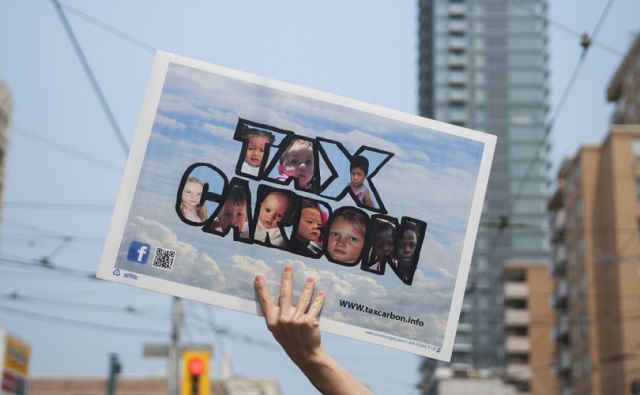Business
Trudeau gov’t has spent nearly $200 million on carbon tax paperwork since 2019: report

From LifeSiteNews
” the Trudeau government was forced to reveal that the tax cost Canadians $82,628,993 last year to collect and then to mail out rebate cheques. The Trudeau government assigned 474 employees to carbon tax paperwork ”
The carbon tax cost Canadians nearly $200 million in paperwork since Parliament introduced the fuel charge in 2019.
According to new records published December 7 by Blacklock’s Reporter, the Liberal government under the leadership of Prime Minister Justin Trudeau spent $199.2 million in taxpayer money on federal administration costs for the carbon tax.
“What were the annual costs to administer collection of the carbon tax and rebate program?” Conservative MP Chris Warkentin questioned in the House of Commons.
In response, the Trudeau government was forced to reveal that the tax cost Canadians $82,628,993 last year to collect and then to mail out rebate cheques. The Trudeau government assigned 474 employees to carbon tax paperwork.
While the Canada Revenue Agency had initially only hired a few employees to manage the carbon tax, the payroll expanded sevenfold after the Trudeau government decided to mail out rebates instead of allowing Canadians to file for the tax credit in their annual returns.
Accordingly, in 2022 there were only 33 employees assigned to the rebate program, but in 2023 the number had risen to 242. Similarly, the total cost of managing the tax rebates increased from $4.3 million in 2022 to $48.6 million in 2023.
Despite the high cost, the Liberal government has maintained that the carbon tax is necessary and the “most efficient” way to cut greenhouse gas emissions.
“Carbon pricing is central to our climate plan because it is the most efficient and lowest cost policy to reduce greenhouse gas pollution,” Canadian Environment Minister Steven Guilbeault claimed last February. “The cost of doing nothing is staggering.”
Similarly, Trudeau defended the cost of collecting the tax last June, saying, “Everyone except apparently the Conservatives understands building in price signals on things we do not want like pollution is one of the most efficient ways of reducing emissions.”
In 2022, Natural Resources Minister Jonathan Wilkinson claimed that 99% of economists agreed on the efficiency of the carbon taxes; however, he failed to cite any paperwork to back up his assertions.
“With respect to the price on pollution, if we asked 100 economists 99 will tell us it is the most efficient way to reduce emissions,” Wilkinson said.
The carbon tax, framed as a way to reduce carbon emissions, has cost Canadians hundreds more annually despite rebates.
The increased costs are only expected to rise, as a recent report revealed that a carbon tax of more than $350 per tonne is needed to reach Trudeau’s net-zero goals by 2050.
Currently, Canadians living in provinces under the federal carbon pricing scheme pay $65 per tonne, but the Trudeau government has a goal of $170 per tonne by 2030.
In October, Trudeau announced that he was pausing the collection of the carbon tax on home heating oil for three years, a provision that primarily benefits the Liberal-held Atlantic provinces. The current cost of the carbon tax on home heating fuel is 17 cents per liter. Most Canadians, however, heat their homes with clean-burning natural gas will not be exempted from the carbon tax.
Despite both Canadians and politicians supporting carbon tax exemptions for all, Trudeau and his government refuse to provide relief.
The government’s current environmental goals – in lockstep with the United Nations’ “2030 Agenda for Sustainable Development” – include phasing out coal-fired power plants, reducing fertilizer usage, and curbing natural gas use over the coming decades.
The reduction and eventual elimination of the use of so-called “fossil fuels” and a transition to unreliable “green” energy has also been pushed by the World Economic Forum (WEF) – the globalist group behind the socialist “Great Reset” agenda – an organization in which Trudeau and some of his cabinet members are involved.
Automotive
Forget Tariffs: Biden Should Look to Domestic Mining to Thwart Chinese EVs

Fr0m Heartland Daily News
By Rick Whitbeck
The Biden administration’s decision to raise tariffs on Chinese-manufactured electric vehicles, steel, computer chips, and other technological products is the epitome of a penny wise and a pound foolish.
To much of the nation, the news was a reelection flip-flop, or an attempt to prop up the electric vehicle industry Biden has prioritized since he took office, as part of his green agenda. The international supply chain for electric vehicles isn’t going to magically stop running through the Chinese Communist Party anytime soon.
If Biden really wanted to curb Chinese geopolitical power, he would make fundamental changes to his administration’s history of attacking domestic mining opportunities. Allowing development of copper, graphite, nickel, cobalt, and other critical and strategic minerals right here at home would go much further than imposing tariffs.
Biden has demonstrated affinity for promoting “net zero” policies and forcing transitions away from traditional energy supplies of oil, gas, and coal. In a nutshell, the attacks on domestic mining projects seem completely counterproductive.
According to the International Energy Agency, staggering quantities of subsurface elements will need to be mined by at least five times their current worldwide production by 2040 to meet the Biden administration’s green energy goals. Graphite, cobalt, and lithium all will be needed in quantities exceeding 25 times (or more) their current supplies. In the next quarter century, we will need twice as much copper than has been produced in the last 3,000 years. All of which is impossible when Biden won’t let us dig.
The U.S. has tremendous opportunities to have our own mineral resources. Yet, the Biden administration has thwarted their development at nearly every turn. For example, massive copper and nickel deposits could be developed in Minnesota at the Twin Metals and Duluth Complex projects, but Biden has ordered each of them off-limits for development. The Resolution Copper prospect in Arizona met a similar fate, with the Department of Interior placing on “indefinite hold” its approval.
The Western Hemisphere’s largest copper prospect is Alaska’s Pebble Mine. Kowtowing to environmental extremists—and ignoring a clean U.S. Army Corps of Engineers’ Final Environmental Impact Statement—the Environmental Protection Agency continues to stymie progress on a deposit worth more than $500 billion. All the while shutting down the possibility of 700 full-time jobs in an area of rural Alaska that has seasonal unemployment exceeding 20%.
Alaska has been the target of more than 60 administrative and executive orders targeting its resource-based economy since Biden assumed office. One of the most recent took place on Earth Day, when a congressionally-authorized road to the Ambler Mining District—an area rich in copper, zinc, and other strategic and critical minerals—was stopped by the Department of Interior.
Just like with the Resolution mine in Arizona, the Interior Department used “Indigenous opposition” as its deciding factor, even though many villages and tribes closest to the mining district publicly support the project and its future employment opportunities. In Alaska, the Biden administration literally blocks the road to the minerals Biden’s tariffs claim to protect.
Alaska’s governor, Michael Dunleavy, along with its entire congressional delegation, has been openly critical of the continued hypocrisy of the Biden administration when it comes to talking “net zero” and acting with vigor to oppose domestic mining projects. The same response has come from many within the Minnesota and Arizona congressional community. They’ve been unable to break through to the administration, as Team Biden chooses to listen to eco-activists and career bureaucrats with an anti-development agenda.
What would hurt China, empower America, and begin to chip away at the global imbalance would be mining and processing our crucial minerals and elements domestically. Let’s see if the Biden administration wises up to that fact, or if America tires of being subservient to the CCP and makes fundamental changes to federal leadership in November.
Rick Whitbeck is the Alaska State Director for Power The Future, a national nonprofit organization that advocates for American energy jobs and fights back against economy-killing and family-destroying environmental extremism. Contact him at [email protected] and follow him on X (formerly Twitter) @PTFAlaska
This article was originally published by RealClearEnergy and made available via RealClearWire.
To read more about domestic mining to escape reliance on China, click here.
To read more about clean energy and mining, click here.
Business
Government red tape strangling Canada’s economy

From the Fraser Institute
The cost of regulation from all three levels of government to Canadian businesses totalled $38.8 billion in 2020, for a total of 731 million hours—the equivalent of nearly 375,000 fulltime jobs.
One does not have to look too deeply into recent headlines to see that Canada’s economic conditions are declining and consequently eroding the prosperity and living standards of Canadians. Between 2000 and 2023, Canada’s per-person GDP (a key indicator of living standards) has lagged far behind its peer countries. Business investment is also lagging, as are unemployment rates across the country particularly compared to the United States.
There are many reasons for Canada’s dismal economic conditions—including layer upon layer of regulation. Indeed, Canada’s regulatory load is substantial and growing. Between 2009 and 2018, the number of regulations in Canada grew from about 66,000 to 72,000. These regulations restrict business activity, impose costs on firms and reduce economic productivity.
According to a recent “red tape” study published by the Canadian Federation of Independent Business (CFIB), the cost of regulation from all three levels of government to Canadian businesses totalled $38.8 billion in 2020, for a total of 731 million hours—the equivalent of nearly 375,000 fulltime jobs. If we apply a $16.65 per-hour cost (the federal minimum wage in Canada for 2023), $12.2 billion annually is lost to regulatory compliance.
Of course, Canada’s smallest businesses bear a disproportionately high burden of the cost, paying up to five times more for regulatory compliance per-employee than larger businesses. The smallest businesses pay $7,023 per employee annually to comply with government regulation while larger businesses pay a much lower $1,237 per employee for regulatory compliance.
And the Trudeau government has embarked on a massive regulatory spree over the last decade, enacting dozens of major regulatory initiatives including Bill C-69 (which tightens Canada’s environmental assessment process for major infrastructure projects), Bill C-48 (which restricts oil tankers off Canada’s west coast) and electric vehicle mandates (which require all new cars be electric by 2035). Other examples of government red tape include appliance standards to reduce energy consumption from household appliances, home efficiency standards to reduce household energy consumption, banning single-use plastic products, “net zero” nitrous oxide emissions regulation, “net zero” building emissions regulations, and clean electricity standards to drive net emissions of greenhouse gases in electricity production to “net zero” by 2035.
Clearly, Canada’s festooning pile of regulatory red tape is badly in need of weeding. And it can be done. For example, during a deregulatory effort in British Columbia, which appointed a minister of deregulation in 2001, there was a 37 per cent reduction in regulatory requirements in the province by 2004.
Rather with plowing ahead with an ever-growing pallet of regulations to be heaped upon Canadian businesses and citizens, government should reach for the garden shears and start reducing the most recent regulatory expansions (before they have time to do too much harm), and then scour the massive strangling forest of older regulations.
Whacking through the red tape would go a long way to help Canada’s economy out of its dismal state and back into competitive ranges with its fellow developed countries and our neighbours in the U.S.
Author:
-

 Automotive2 days ago
Automotive2 days agoForget Tariffs: Biden Should Look to Domestic Mining to Thwart Chinese EVs
-

 COVID-196 hours ago
COVID-196 hours agoWenstrup Releases Francis Collins’ House Testimony
-

 Great Reset2 days ago
Great Reset2 days agoCanadian MP warns new WHO pandemic treaty may enshrine COVID-era freedom restrictions
-

 Media2 days ago
Media2 days agoTrudeau’s Online News Act has crushed hundreds of local Canadian news outlets: study
-

 Economy2 days ago
Economy2 days agoOil Lobby Working With Republicans Behind-The-Scenes To Push ‘Gateway’ To Carbon Tax
-

 Frontier Centre for Public Policy24 hours ago
Frontier Centre for Public Policy24 hours agoThey spent $8,000,000 without putting one shovel in the ground
-

 Agriculture1 day ago
Agriculture1 day agoResearch Suggests Cattle Raising May Reduce Emissions






